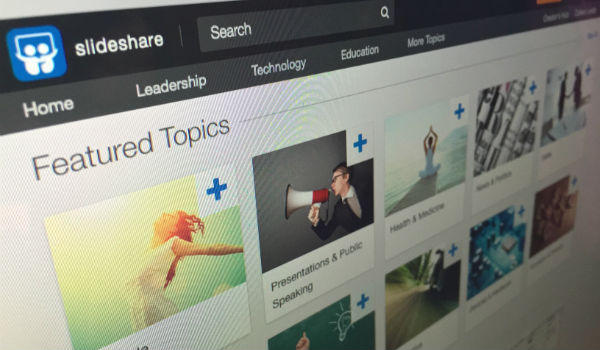
Managing different types of content and where they fit into an integrated marketing mix across customer segments and stages of the buying cycle can be overwhelming. Amongst all the content that brands, publishers and consumers create, only the most authoritative sources are able to capture consumers’ attention.
Why is authority important in content marketing? Authority engenders trust, confidence and can motivate people to take necessary next steps.
Becoming authoritative in an age of information overload requires more than simply creating additional content. It requires content that attracts relevant audiences and engages readers to take action. Creating content authority also requires strategy, process and the right tools.
One of those tools is SlideShare. As a platform for hosting authoritative content, marketers can use SlideShare to build influence amongst interested subscribers, visitors from social networks like LinkedIn and readers that pull themselves to SlideShare content through search engines.
There are many forms of content published on SlideShare. Four types that are particularly useful for differentiating your brand and creating authority include: evergreen, co-created, repurposed and curated content.
Here’s how content marketers can use these 4 types of content on SlideShare as a content marketing secret weapon for building authority, trust and reach where it matters most.
Evergreen Content
Content that withstands the test of time for relevance and usefulness is often considered evergreen. For example, if your company wrote on the topic of “What is Digital Marketing?” it would arguably be an example of an evergreen topic. However, if your topic was about “Top Digital Marketing Trends for 2015”, not so much.
Because evergreen content has a long shelf life, it has time to attract many readers, shares and links that combine to attract even more readers citing the content creating even more signals of authority.
Evergreen content is specific and deep in nature and can include: FAQ’s, comprehensive information on a topic or how-to’s and tutorials.
Example: HubSpot’s “20 Quick Tips to Make Blogging Way Easier”
This SlideShare deck represents both evergreen content in “how-to” form as well as crowd-sourced content since the tips came from the HubSpot community. Whether readers viewed this presentation last year or see it next year, the content is still relevant and useful.
Co-Created Content
Imagine that you have a “game changing” message to share with your community. Now imagine that you have a group of other reputable individuals that participate in creating and sharing that message. This is content co-creation or “participation marketing”.
Why co-create content? For one, content co-created with your community can be better because the collaboration of smart people with different perspectives creates a more trusted resource. Secondly, the potential for social amplification is much higher because when someone takes the time to contribute to a project that results in content, the likelihood of sharing it with his or her networks increases significantly.
Co-created content can take on many forms. Everything from blog posts to guides to eBooks like the one TopRank Marketing co-created with speakers at Copyblogger’s Authority Rainmaker conference.
By partnering with the community to create a useful content asset together, each individual participant spends less time creating and is inspired to spend more time helping to promote. Success of the co-created content object is in everyone’s interest.
Repurposed Content
When creating any content marketing deliverable, marketers should always consider additional ways the content can be repurposed. Deconstructing content into component parts, also known as modular content, enables marketers to get more value from the initial content investment. It also makes customizing the deconstructed content easier for specific target audiences.
As an example, Unbounce has blogged for several years about optimizing landing page copy, forms and how to increase conversions. Unbounce unleashed a Lead Gen Landing Page Course delivered by email over 7 days using much of the same content that was previously published.
Along with the course, Unbounce hosted a webinar for KISSmetrics titled “How to Design High Converting Lead Gen Landing Pages” reusing the blog content and posted the presentation to SlideShare.
There are many ways to repurpose content in ways that can be leveraged on SlideShare. From deconstructing an eBook into blog posts and blog posts into a SlideShare presentation to taking topically specific tips from a series of interviews or articles and compiling them into a themed presentation, there’s no end to extending the value of content.
Just keep in mind that repurposing only works if the resulting content is useful to readers.
Curated Content
Content curation can be described as identifying, gathering and repackaging content around a similar theme. It can be an incredibly effective, and fairly simple content marketing tactic to execute.
NewsCred took an incredibly simple topic, “content marketing quotes”, and turned it into a SlideShare presentation called “56 Reasons Why Content Marketing Works”.
The presentation is filled with quotes curated from some of the marketing industry’s leading authorities on content marketing. This type of curated content enables NewsCred to be a part of the content marketing “conversation” alongside industry experts without having to create much of the content themselves.
By publishing content on SlideShare that is evergreen and timeless, co-created with your community or industry influencers, curated from useful resources or repurposed in a relevant way, you can build your brand’s authority to attract, engage and convert new customers.
Just remember, SlideShare is a content marketing secret weapon, so be careful where you point it!
With well over 1 million views, you can check out the TopRank Online Marketing SlideShare collection of presentations and eBooks here.
This post originally appeared on the SlideShare Blog


